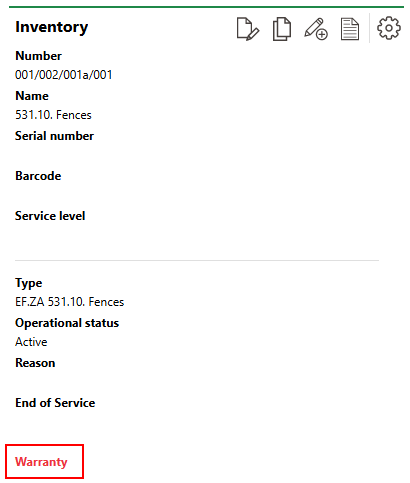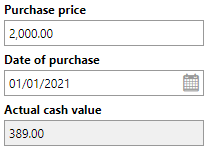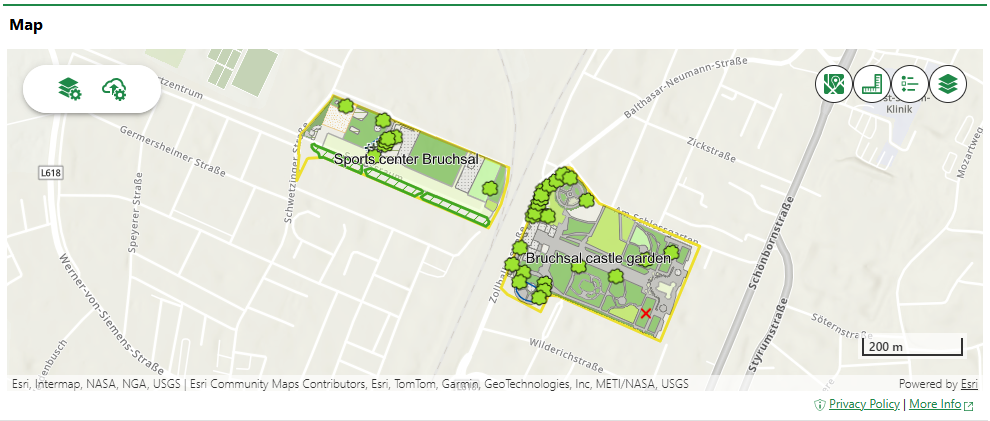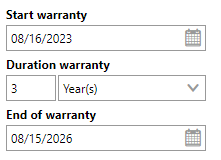Inventory items refer to assets installed or used in green areas, partial areas, and functional units.
Examples of inventory items managed in VertiGIS FM Greenspaces could include swings, slides, sandboxes, protective equipment, benches, fences, irrigation systems, bicycle racks, tree guards, or any other assets or systems used in your green areas.
Details Page
Each inventory item has its own details page that stores its properties and associated data objects. You can navigate to a inventory item's details page either of two ways:
•by clicking Inventory under Operational Procedures on the VertiGIS FM Greenspaces legacy start page and then double-clicking an inventory item in the list, or
•by double-clicking an inventory item in the Objects section on the details page of the version that contains the inventory item.
Details
Each inventory item has the following core properties.
Inventory Item Details
Field |
Description |
||||||||||
|---|---|---|---|---|---|---|---|---|---|---|---|
Type |
The inventory item's version. Refer to Inventory Management Hierarchy. |
||||||||||
Number |
A serial code to identify the inventory item. |
||||||||||
Name |
The name of the inventory item. This value typically reflects the inventory item's group and version. |
||||||||||
Serial number |
The inventory item's serial number. |
||||||||||
Barcode |
|
||||||||||
Service level |
A classification that indicates the level of service or maintenance the inventory item requires. Selectable options are stored in the Service Level catalog. You will be unable to create maintenance intervals, orders, and inspections for the inventory item without assigning it a service level in this menu. Examples could include major disruption, high safety risk, or general defect. |
||||||||||
Location |
The green area or functional unit in which the inventory item is located. You must first double-click the maintenance area and maintenance district in which the green area or functional unit is located before selecting a green area or functional unit and clicking Apply. This field is only visible when you are adding an item to the inventory. After the new inventory item is saved, you can change its location in the Location section on the inventory item details page. Refer to Install Inventory Item in a Location. |
||||||||||
Operational status |
The status of the inventory item. Selectable options are
|
||||||||||
Reason |
A reason that explains the status selected in the Operational Status field. Selectable options are saved in the Reason catalog. |
||||||||||
End of service |
The date until which the inventory item can be used. |
Commercial Characteristics
Field |
Description |
|---|---|
Division |
The department or division of the company the inventory item belongs to. Selectable options are stored in the Divisions section on the Divisions section on the Own Company or Tenant administration page |
Person responsible |
A person who can be contacted for inventory item maintenance or information. You must select a contact or company stored in the Contact Management module. |
Organization |
The organization or department within your company associated with the inventory item. Selectable options are stored in the Organisations section on the Own Company or Tenant administration page. |
Ownership |
The commercial status of the inventory item. Selectable options are stored in the Ownership catalog entry. |
Purchase price |
The price for which the inventory item was purchased. |
Date of purchase |
The date the inventory item was purchased. |
Actual cash value |
The market value of the inventory item. |
Cost center |
The cost center to which maintenance or consumption costs incurred by the inventory item are to be charged. An option must be selected from the set of cost centers created in the Costs and Budgets module. |
Cost object |
The cost object associated with the inventory item. |
Start warranty |
The date the inventory item's warranty started. |
Duration warranty |
The length of the inventory item's warranty. |
End of warranty |
The date the inventory item's warranty ends. |
Manufacturer |
The organization that manufactured of the inventory item. You must select a company stored in the Contact Management module. |
Manufacturer no. |
A manufacturer-assigned tracking number. |
Supplier |
The organization that supplied the inventory item. You must select a company stored in the Contact Management module. |
Installer |
The party that installed the inventory item. You must select a company stored in the Contact Management module. |
Inventory number |
An internal tracking number. |
Last stock-taking |
The date the inventory item was most recently accounted for in an inventory check. |
Warranty
When you enter the Start Warranty and one of the Duration Warranty or End of Warranty fields and click Save, VertiGIS FM populates the third field based on the warranty data entered.
|
|
|
When you save the form with a valid warranty, a warranty message appears in red text on the inventory item's details page to indicate that the inventory item is covered by a warranty. This message no longer appears after the warranty expires.

Warranty Warning on the Item's Details Page
Value
VertiGIS FM can calculate an estimated market value of the inventory item in the Actual Cash Value field if you enter the Estimated Service Life value in the Technical Characteristics tab and the Purchase Price and Date of Purchase in the Commercial Characteristics tab. This feature allows you to make cost-sensitive decisions about the maintenance of the asset. For example, you may decide that a damaged asset that is no longer under warranty should not be repaired because the repair cost exceeds the value of the asset.

Value Field in the Commercial Characteristics Tab
Technical Characteristics
Field |
Description |
|---|---|
Model no. |
A serial number or product code for the inventory item. |
Year of construction |
The year the inventory item was manufactured. |
Installed on |
The date the inventory item was installed in its location. You must update this field manually. VertiGIS FM does not update it programmatically when you update the inventory item's location. |
Start-up Date |
The date the inventory item has been in production since. |
Estimated service life |
The estimated lifespan of the inventory item. Refer to Estimate Service Life for more information. |
Quantity |
The quantity of the inventory item. This field could be used if, for example, an organization has hundreds of identical demo devices but finds it sufficient to only create one instance of it in VertiGIS FM. |
Width [m] |
The width of the inventory item in meters. |
Length (depth) [m] |
The length of the inventory item. |
Height [m] |
The height of the inventory item. |
Diameter [m] |
The diameter of the inventory item. |
Weight [kg] |
The weight of the inventory item. |
Icon |
The symbol that represents the inventory item graphically in CAD drawings. Symbols that have been created under Administration can be selected. |
Comment |
Additional comments regarding the inventory item's commercial details. |
Several properties in the Commercial Characteristics tab are assigned to a new inventory item programmatically based on the property values in the Default Values section of the version to which they are added.
Estimated Service Life
It is important to enter the Estimated Service Life so that VertiGIS FM can calculate the market value of the inventory item. Refer to Value in Commercial Characteristics for more information.

Technical Characteristics Tab on the Device Details Page
Playground Equipment
Field |
Description |
|---|---|
Flooring |
The type of flooring or surface on which the inventory item can be installed. Selectable options are saved in the Flooring catalog. |
Height of fall |
How far a person can fall off the equipment when using the inventory item. |
Railing |
Whether the inventory item has a railing. |
Hampered access |
Whether access to the inventory item is in any way blocked. |
Device combination |
|
Map
If the Map section is available on the inventory item details page, the inventory item's location is shown on a web map from a VertiGIS Studio application that has been integrated with VertiGIS FM.
Inventory items are not associated with a street address and require polygons to appear on a web map. Therefore, they cannot be viewed on the Open Street Map (OSM).

Green Area Shown on an Integrated VertiGIS Studio Web Map
If your organization has integrated its own VertiGIS Studio web map with VertiGIS FM and mapped a layer to inventory items, you can click the Locate (![]() ) icon on the inventory item details page to manage the GIS feature associated with the inventory item.
) icon on the inventory item details page to manage the GIS feature associated with the inventory item.

Locate Icon on the Device Details Page
Clicking the Locate button opens the Edit Object workflow. This allows you to move the location of the inventory item's corresponding feature in the GIS, unlink the inventory item and the feature so that changes to the item in the GIS are not reflected in the VertiGIS FM database (and vice-versa), or delete the GIS feature so that the inventory item only exists as an object in VertiGIS FM.
The Maps section does not appear on the inventory item details page if inventory items are not mapped to any layers in an integrated VertiGIS Studio web map and the Open Street Map (OSM) is not activated.
Functional Units
The Functional Units section indicates the inventory item's functional unit.
You can add the inventory item to a functional unit on the details page of the functional to which you want to add it. Refer to Add Inventory to a Functional Unit for instructions.
Standing Orders
The Standing Orders section lists intervals that generate inspections or maintenance orders for the inventory item. Refer to Manage Inventory Orders and Inspections for more information.
Inspections generated by inspection intervals in this section appear in the Inspections section. Maintenance orders generated by order intervals appear in the Orders section.

Separate Intervals for Inspections and Orders
Damages
The Damages section lists documented damages associated with the inventory item. Refer to Document Damages for more information and instructions.
Inspections
The Inspections section lists inspections scheduled for the inventory item. These can include inspections generated by an interval in the Standing Orders section as well as manually created individual inspections.
Refer to Manage Inventory Orders and Inspections for instructions on how to create inspection intervals, manually create inspections, and mark inspections as complete.
Orders
The Orders section lists orders scheduled for the inventory item. These can include orders generated by an interval in the Standing Orders section as well as manually created individual orders.
Refer to Manage Inventory Orders and Inspections for instructions on how to create order intervals, manually create orders, and mark orders as complete.
Location
The Location section lists the green areas, partial areas, or functional units in which the inventory item has been installed.

Location Section
You can double-click a green area, partial area, or functional unit in this section to navigate to its details page.
A inventory item can only be installed in one location at a time. Therefore, the time spans marked by the From and Until fields cannot overlap.
Refer to Install Inventory in a Location.
Green Area
The Green Area section indicates the green area or functional unit in which the inventory item is currently installed. You can navigate to the green area's of functional unit's details page by double-clicking it.
If the inventory item is installed in a partial area, this section will indicate the green area in which the partial area is located.
Partial Area
The Partial Area section indicates the partial area in which the inventory item is installed. You can navigate to the partial area's details page by double-clicking it.
This section does not appear if the inventory item is not currently installed in a partial area.
Documents
The Documents section lists the documents, including image files, associated with the inventory item. Refer to Document Management for more information, including instructions on how to upload a document.


